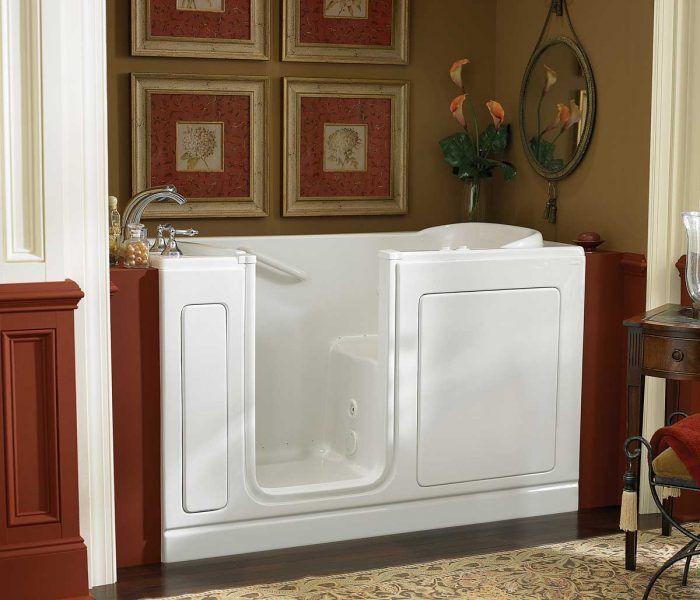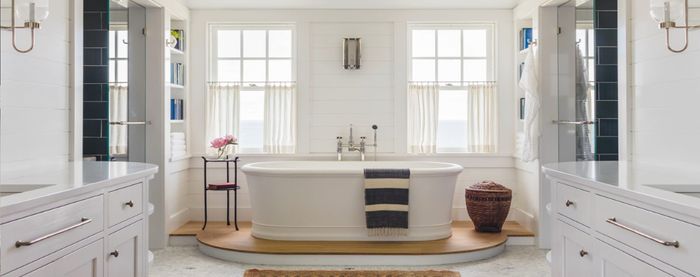Tubs for Small Spaces
When a standard 5-ft. tub won't fit the bathroom, consider one of these alternatives.

Synopsis: A standard bathtub is 5 ft. long, but some bathrooms can’t accommodate a tub of that size. As a result, some manufacturers offer tubs designed to fit into smaller spaces. In this article, longtime Fine Homebuilding contributor Jefferson Kolle looks at four categories of small tubs: walk-in tubs, which are equipped with watertight, in-swinging hinged doors; above-floor-drain tubs, which allow installation above the floor joists; corner tubs, which are available as either freestanding or drop-in units; and soaking tubs, extra deep units that can be built into a tiled surround or mounted freestanding on the floor.
A standard bathtub is 60 in. long and 30 in. to 32 in. wide. There’s no such thing as a standard bathroom, though, especially because people are tucking them into smaller spaces in their homes.
To help outfit these compact spaces, several manufacturers make standard-shape tubs in small sizes. For instance, American Standard’s Huron is available in a 4-ft.-long model ($325), and Vintagetub.com sells a 4-ft.-long claw-foot tub with a 29-gal. capacity ($900 to $1200). Before you envision a lanky movie cowboy shivering uncomfortably in a galvanized basin, though, know that there are small tubs that still hold a lot of water. A corner, safety, or soaking tub could be just what you need.
Before you buy a small tub, it’s a good idea to study all the literature. Most tubs are sold without fixtures, which can get quite pricey, and drains. For something as large as a tub, even a small one, shipping can be expensive — and don’t forget return shipping if you make a mistake. Talk to your plumber about any reservations either of you might have; know that some soaking tubs may not have built-in overflow drains. If you’re going to do your own installation, plan on a few trips to the plumbing-supply store.
Walk-in tubs not just for the immobile
Among other things, the Americans With Disabilities Act (www.ada.gov) made buildings more accessible to people in wheelchairs. It also gave rise to a whole line of walk-in bathtubs that are easy to get in and out of for people who might have trouble lifting their legs over the high wall of a standard tub.
Walk-in tubs are equipped with watertight, in-swinging hinged doors. When the tub is filled, water pressure pushes the door tighter to the jamb, securing the seal. The bathing position is more upright than in a conventional tub; you sit while bathing, rather than lie horizontally.
Consequently, while the tubs’ footprints are smaller, their water capacities can be as generous as standard tubs. (Think of the difference between a bowl filled with water and a drinking glass filled with water.) It’s common for these tubs to be equipped with sturdy stainless-steel handrails, but before you think that they are going to make your beautiful bathroom look like a dreary nursing home, know that they are sleek, elegant, and designed for residential use.
Walk-in tubs are more complicated, and the price reflects that added complexity. Prices range from $1600 to $5500, depending on the size, material, and amenities (faucets, whirlpool, or air jets).
Safety Tubs (www.safetytubs.com) makes a line of walk-in tubs (photo facing page), the smallest of which has a footprint of 48 in. by 28 in. by 38 in. The tubs are either acrylic or gel-coated fiberglass, and they have a water capacity of 45 gal. A built-in seat is molded into the body of the tub, and you can order them with water and/or bubble jets.
Acrylic tubs are vacuum-formed over a mold and are reinforced with fiberglass, creating a continuous, nonporous waterproof membrane. Gel-coat tubs are made from colored polyester resins sprayed into a mold and reinforced with fiberglass particles. Generally, acrylic tubs cost more than gel-coat models, but they are stronger, retain their glossy, colorfast finish longer, and are easier to clean.
The Model 26, the smallest walk-in tub made by Bathing Solutions (www.bathingsolutions.com), is only 26 in. by 53 in. by 37 in., making it easy to fit through even the smallest doorway.
Walk-in tubs are made in a variety of configurations; you can specify a left- or right-swinging door, which is handy for small bathrooms. Many have more than one drain and often a pump that helps the water to evacuate quickly so that you don’t have to sit too long in cooling water before you are able to swing open the door.
Small tubs for renovations
Adding a small tub to an existing bathroom or turning a small room in your house into a bathroom can present a set of problems beyond just finding the floor space. Or maybe your bathroom already has a tub that needs replacing.
Tub drain-line traps typically hang in the bay between floor joists. This can present problems in existing homes, especially older ones that might have joists less than 8 in. deep. In some cases, you may not be able to access a finished ceiling below where you want to install a tub, or there could be a beam or other structural member that can’t be cut.
Manufacturers have the perfect workaround for cases such as these. Above-floor-drain (AFD)—sometimes known as above-floor rough-in (AFR)—tubs are built on a pedestal so that drainpipes can run under the tub but above the floor joists (drawing below). This means that you won’t have to cut into the existing floor to plumb a drain. From outside the tub, AFD models appear to be deep, but if you look into the tub basin, you’ll see otherwise.
American Standard’s Princeton AFR tub is 60 in. by 30 in. with an exterior height of 171⁄2 in. However, the bathing depth is only 131⁄4 in. Kohler’s Dynametric AFR tub is 60 in. by 32 in. with a 161⁄4-in. height. The bathing depth is 13 in., and the tub holds 35 gal.
If ceiling-height clearances are minimal, there may not be enough headroom to stand up in an AFD tub.
Corner tubs: A fit for unused spaces
An unused corner in a small bathroom can be the perfect place to shoehorn in a corner tub. Available as either freestanding or drop-in units (which require you to build a surround), they are made in a variety of materials and colors.
Canadian-based Neptune (www.produits neptune.com) has a corner tub called the Wind that is as sleek as it sounds. The Wind is somewhere between a standard rectangular tub and a traditional triangular corner tub. The 60-in. by 30-in. by 20-in. tapered footprint is 21 in. deep, holds 56 gal., and sells for $1300.
Signature Hardware’s (www.signaturehardware.com) $1500 Angelique—a full-featured, curved-front, freestanding tub that’s 52 in. by 52 in. by 22 in.—has a waterfall-style faucet, a built-in pillow, and a handheld showerhead.
Kohler makes a drop-in corner tub that’s only 54 in. by 54 in. by 201⁄2 in. The Proflex has a clipped front edge that protrudes from the corner of a room a mere 561⁄2 in., yet the tub holds 76 gal. and fits two people. It’s available in almond, white, and biscuit, with optional pillows and footrests. You can order it through a Kohler dealer or from Amazon.com with free shipping for just more than $900.
Soaking tubs: Deep bath, small footprint
In traditional Japanese culture, bathing is a full-immersion experience—a contemplative ritual. Similar to walk-in tubs, Japanese tubs are deep and are often equipped with a seat. Although some are large enough to accommodate the whole family at once, many single-person soaking tubs are perfect for smaller bathrooms. Available in materials from traditional coopered-wood slats to stone, composites, or metal, soaking tubs can be built into a tiled surround or mounted freestanding on the floor.
If you’re considering a freestanding tub, talk to your plumber about installing a floor drain in your bathroom. It can be relatively cheap insurance against wayward splashes, especially when exuberant children are involved.
 |
 |
Premier Copper Products (www.premiercopperproducts.com) makes a cylindrical, hammered-copper Japanese-style tub with an inner diameter of 39 in. and a height of 36 in. (photo above left). Pricey (about $5700) and beautiful, the tub includes a built-in seat. If stone is your particular extravagance, check out the $20,000 Oval Soaking Tub (photo above right) made by Stone Forest (www.stoneforest.com). You also should consult a structural engineer for this one; the dry weight of the 48-in. by 39-in. by 42-in. tub, which has a 100-gal. capacity, is 2400 lb.
If you want to save some of your bathing-experience funds for new rubber duckies, there are a few soaking tubs that will cost you a lot less. The freestanding Ofulo 1—about $900 from At House (www.at-house.com)—has inside dimensions of 311⁄2 in. by 231⁄2 in. by 231⁄2 in. and a 66-gal. capacity (photo below). The fiberglass tub, made in Japan, is primarily meant to be installed in an existing shower and drains into the shower’s drain. It’s available in either a left- or right-hand drain and has an integral cover.
Jefferson Kolle is a freelance writer living in Bethel, Conn. Photos courtesy of the manufacturers.
Drawing: Trevor Johnston
From Fine Homebuilding #223
Fine Homebuilding Recommended Products
Fine Homebuilding receives a commission for items purchased through links on this site, including Amazon Associates and other affiliate advertising programs.

Affordable IR Camera

Reliable Crimp Connectors

Handy Heat Gun










